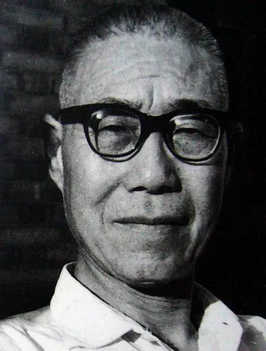Pan Tianshou
Pan Tianshou (March 14, 1897 – September 5, 1971), style name Dayi, self-styled Ashou [1], Shouzhe, was from Ninghai, Zhejiang Province. A modern painter and educator. [2]
In 1915, he entered the Zhejiang Provincial No. 1 Normal School, studying under Jing Hengyi, Li Shu Tong, and others. His ink-wash flower-and-bird paintings initially learned from Wu Changshuo, later drawing inspiration from Shi Tao and Bada Shanren. He served as Vice Chairman of the China Artists Association, President of the Zhejiang Academy of Fine Arts, and other positions. He was a delegate to the First, Second, and Third National People’s Congresses and a member of the China Federation of Literary and Art Circles. In 1958, he was appointed Honorary Academician of the Soviet Academy of Arts. He authored works such as A History of Chinese Painting and Talks and Notes from the Hall of Listening to Heaven. [13] He passed away on September 5, 1971.
Born in Guanzhuang Village, Ninghai County, Zhejiang Province, in 1897.
In 1903, his mother died of illness. That summer, he enrolled in a private village school. Besides daily literary exercises, he enjoyed calligraphy and enthusiastically copied illustrations from novels such as Romance of the Three Kingdoms and Water Margin.
From 1915 to 1920, he studied at the Zhejiang Provincial No. 1 Normal School.
In spring 1920, he participated in progressive student movements at Zhejiang No. 1 Normal School. That summer, he graduated and returned to Ninghai to teach at Xiazhengxue Primary School. In his spare time, he diligently practiced painting, calligraphy, poetry, and seal carving. He created “Sparse Forest and Cold Crows” and “Evening Mountains and Distant Bells” for Zhao Pingfu (Rou Shi).
In spring 1923, he taught at the Shanghai Republican Women’s Vocational School. That summer, he concurrently served as an instructor in Chinese painting practice and theory at the Shanghai Art College. He met Wu Changshuo, Wang Yiting, Huang Binhong, Wu Fuzhi, and Zhu Qizhan; his style gradually drew closer to Wu Changshuo’s, evolving from bold, free expression toward profound subtlety. He created works such as “Autumn Flowers Damp with Dew.” He changed his name from “Tianshou” to “Tianshou.”
Compiling a History of Painting
In 1924, he became a professor at the Shanghai Art College and began writing A History of Chinese Painting.
In July 1926, his compiled A History of Chinese Painting was published by The Commercial Press.
In early spring 1928, he was invited to serve as Chief Professor of Chinese Painting and instructor for the Painting and Calligraphy Research Society at the National Hangzhou Art Academy. From then on, he settled permanently in Hangzhou. He also taught at the Shanghai Art College, Xinhua Art College, and other institutions.
In 1932, he published the second volume of the Bai She Painting Collection and participated in the “Exhibition of Recent Works by Professors of Xinhua Art College.”
In 1933, his works were included in Xu Beihong’s “Exhibition of Modern Chinese Painting” held in Paris, France. From October 17 to 22, the second exhibition of “Bai She” was held in the auditorium of Central University. He revised A History of Chinese Painting and drafted the initial version of A History of Chinese Calligraphy.
In 1936, his revised A History of Chinese Painting was republished as part of the “University Series.” In August, the fourth exhibition of “Bai She” was held at the Suzhou Park Library. He created “Dream Journey to Mount Huang.”
On April 1, 1937, Pan Tianshou’s works “Ink Cat” and “Standing Scroll in Running Script” were exhibited at the “Second National Art Exhibition” held at the Nanjing Art Exhibition Hall. “Night Mooring on the River” was displayed at the “Sixth Exhibition of the Chinese Painting Society.”
In 1943, he wrote An Examination of Chinese Painting Academies. He organized his accumulated poems into a collection titled Poems from the Hall of Listening to Heaven for publication. He created “Deep Autumn Drunkenness” and “Handscroll on Painting Theory in Running Script.”
Teaching Career
From 1944 to 1947, he served as President of the National Art College.
After 1949, he successively held positions including Vice Chairman of the China Artists Association, Vice Chairman of the Zhejiang Federation of Literary and Art Circles, Chairman of the Zhejiang Branch of the China Artists Association, Vice President of the East China Branch of the Central Academy of Fine Arts, and President of the Zhejiang Academy of Fine Arts. He was a delegate to the First, Second, and Third National People’s Congresses and a member of the China Federation of Literary and Art Circles.
In 1950, he became Director of the “Research Room for National Art” at the East China Branch of the Central Academy of Fine Arts. Together with Wu Fuzhi and Zhu, he extensively collected, authenticated, classified, cataloged, mounted, and restored folk paintings, significantly enriching the academy’s collection and providing ample visual teaching materials. He created figure paintings including “Eagerly Paying Agricultural Taxes,” “Cultural Workers Visiting Poor Peasants,” and “Growing Melons to Survive Spring Hunger.”
In 1955, he delivered a speech titled “Reflections on Artistic Ideology,” clearly articulating his views on developing national art. He created “One Corner of Lingyan Ravine” and “After the Plum Rain Clears.”
In 1957, he published “Memories of Master Wu Changshuo” in Issue 1 of Art magazine. He published “An Overview of Wu Daozi’s Life” in Issue 1 of Art Research, and “Who Says ‘Chinese Painting Will Surely Vanish’?” in Issue 4. He created “Recording the Wildflowers of Yandang Mountain” and “Gleaming Landscape.”
Late Years
On April 1, 1959, he published “We Need Even More Beautiful Paintings” in the Wen Hui Bao. He drafted the preliminary version of A Brief History of Flower-and-Bird Painting. He was invited to participate in the Soviet exhibition “Our Contemporaries” with works such as “Vulture,” “Small Boats,” and “Newly Clear After Rain.”
In April 1961, at the “National Conference on Humanities Textbooks for Higher Education Institutions” in Beijing, he proposed the suggestion of separating Chinese painting instruction into distinct disciplines—figure, landscape, and flower-and-bird—and wrote “Opinions on Separating Figure, Landscape, and Flower-and-Bird Painting into Independent Disciplines in the Chinese Painting Department.”
In April 1962, he published “On the Achievements of Huang Binhong’s Landscape Painting” in Issue 10 of Donghai Magazine. He created “Rain Cleared” for the Embassy of Myanmar in China.
On New Year’s Day, 1963, the “Pan Tianshou Painting Exhibition,” hosted by the Shanghai Artists Association and the China Academy of Art, opened at the Shanghai Art Museum. Under Pan Tianshou’s leadership, with assistance from students such as Ma Jinliang (Jingliang), the academy formally established the Department of Calligraphy and Seal Carving.
In spring 1965, he joined faculty and students in participating in rural socialist education campaigns in Shangyu County.
In early June 1966, the Cultural Revolution erupted; he was imprisoned in a “cowshed” for three years.
In early 1969, he was taken on public humiliation tours to his hometown Ninghai County and other places. On the return journey to Hangzhou, he wrote his final poem on the back of a cigarette packet: “Do not think this cage is narrow; my heart is as vast as heaven and earth. Right and wrong are entangled in nets; injustice has existed since ancient times.” In April, while seriously ill, he was forced to labor in a factory. Suffering from heart failure leading to unconsciousness, he was rushed to the hospital but thereafter remained bedridden.
In August 1970, due to lack of timely and serious medical treatment, he developed severe hematuria.
Before dawn on September 5, 1971, Pan Tianshou passed away. [3]

 中文
中文  en
en 
